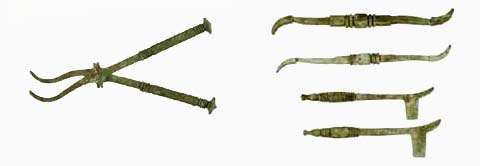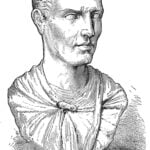Chapters
The doctors were mostly foreign slaves or freedmen. With a little skill and a lot of luck, slave doctors made fortune, achieved liberation, and even citizenship.
Roman society was highly distrustful of foreign doctors. Many Romans used the services of suspicious medics offering mysterious ointments, elixirs or praying to the gods. The most commonly prescribed medications were various herbal mixtures and exercise in line with the saying that “in a healthy body, a healthy mind”. In turn, cabbage and wine served as a panacea for all ailments.
At first, the Romans did not respect medical conditions. Treated with simple home remedies. Cato the Elder writes that the father of the family should have the appropriate knowledge, pater familias. The first doctors were often Greek slaves (servi medici). It was not proper for a Roman to pursue this profession. There were also plenty of charlatans, ignorant quacks and magicians. Initially, there were virtually no medical schools. Methodologists even believed that six months of training was sufficient. Besides, the doctors had dangerous knowledge. They knew poisons – one of the most effective ways of succession to power. There are many examples of poisoning emperors in the history of Rome. Among others, Claudius was harmed by toadstool sauce, Nero’s aunt – a killer laxative, and Titus – an undefined poison. The king of Pontus, Mithridates VI, was a lover of poisoning, who was researching on himself a universal antidote consisting of over 50 ingredients.
We know that the military had its own hospitals and surgeons, who sometimes healed better than their urban counterparts. Many outstanding doctors became famous in Rome: Asklepiades, Galen, Cornelius Celsus. Galen became famous as the father of experimental physiology, reportedly conducting autopsies on monkeys. Cornelius Celsus (Cornelius Aulus Celsus), was the author of a medical encyclopedia and a treatise on medical procedures. Interestingly, it turns out that the ancients knew anaesthetics and the methods of sterilizing tools. In addition, it is worth mentioning that doctors were often forced to perform operations in the street, fearing that the patient might not survive the transport to the hospital.
In the 2nd century BCE, the success of the wound surgeon Archagatos paved the way for other doctors. They slowly gained recognition (and money). Julius Caesar granted them civil rights, August exempted them from taxes and Hadrian – from military service. The chronicle of Roman medicine lists many famous physicians: Dioscorides of Anabra (1st century CE) – he wrote the most important ancient textbook on herbal medicine describing more than 600 plants; and the aforementioned Celsus became famous for eight books on medicine. It describes, inter alia, plastic surgery of the face with the shift of the skin flap. Scribonius Largus is famous for its collection of recipes, including how to obtain opium from poppy heads. Antillos, the famous surgeon, described tracheotomy, laryngeal intubation, bleeding techniques, and needle-prick cataract surgery. Soranos of Ephesus (93-138 CE), a specialist in obstetrics and female diseases, in his work mentions the use of a birthing chair, a speculum, and lists the procedures during childbirth and diseases of the reproductive organs.
The Romans healed the sick by combining common sense, faith in gods and magic because superstitions flourished in Rome. Goat dung mixed with wine was proposed as a treatment for broken ribs, and saliva was supposed to protect against snake venom. The most important preventive measures were inspired by common sense, which was Rome’s unmistakable contribution to the history of medicine. In a treatise on medicine from the 1st century BCE, Celsus recommended exercise and a rational diet as the surest way to keep fit.
The Romans also understood the importance of hygiene and regular baths in clean spring water. The latrines were usually rinsed with water from the baths. However, knowledge of anatomy was extremely poor, and it was rather the doctors from the East who constantly made efforts to understand the functioning of the human body. Soranos, a physician from Ephesus who, during the reign of Trajan, practised in Rome, specialized in gynaecology and Galen, the father of experimental physiology, impressively enriched his knowledge of the human body by dissecting monkeys. Although many diseases remained incurable, the pioneers of medicine made our contemporaries aware of the importance of careful observation of the patient.
The Romans also believed that diseases and wounds healed faster if they sacrificed to the gods a model of a diseased body part. So when they visited the temple, they would leave a model of the ear in it, praying for the healing of their earache. Sometimes they also offered thanksgiving when the ear had healed.
Pharmacies
Many treatments prescribed by Roman doctors were based on herbs. Pharmacists, following the doctors’ instructions, prepared herbal mixtures, the use of which was supposed to bring relief to the suffering (patiens, patientis).
Pliny the Elder in his work “Natural History” provides a description of herbs used by the Romans and lists over 40 different plant names. An extremely popular ingredient in medicinal mixtures was garlic, used both in the treatment of leprosy and mental diseases. The mustard diluted in cucumber sauce was supposed to cure epilepsy, and the golden-headed ones brought relief to those suffering from ulcers and warts.
The pharmacists of the ancient Romans collected herbs and gave them to doctors to mix them according to their own recipes.
Hospitals
The first real hospitals (valetudinaria) were built during the reign of Octavian Augustus, before 14 CE – for legionaries. They were created where the largest groups of Roman troops were located, on the distant frontiers of the Empire – in Germany (Novaesium on the Rhine), on the Danube (Carnuntum – near Vienna), in Africa North or in today’s Scotland. The ruins of Roman hospitals, as well as the plans that have survived, prove that they were extremely impressive structures, even judging from today’s perspective. They were built on a square plan, with a spacious vestibule and a central courtyard. The largest of them consisted of about 60 rooms for patients, 2-3 in one room. The conditions for the patients were therefore comfortable, even for today’s times. The bathrooms were equally comfortable – with hot, lukewarm and cold water, as well as the quarters of numerous staff. Because not only doctors work in these hospitals, but also writers, inspectors, and even specialists in the preparation of drugs.
Similar hospitals were later built in Rome for imperial service. Following their example, similar buildings were founded by the greatest wealth in Rome for their numerous slaves.
Surgery
Due to the lifestyle, constant wars, battles and conquests, dressing the wounded was almost the order of the day with the Romans. The aforementioned doctor Galen reportedly learned some surgical procedures while caring for injured gladiators. Each legion had its own medical team qualified to treat wounds and injuries suffered while serving in the army. Medics were able to make a diagnosis about the dangers of a specific wound, when to leave the arrowhead in the body, and when to try to remove it. The legions also had their own well-equipped hospitals. In one of them, located near the Germanic border, archaeologists discovered hearths in which surgical instruments were sterilized. The most complete picture of the work of Roman surgeons is given by the treatise by the aforementioned Cornelius Celsus on medical procedures. According to the advice of the ancient physician, the surgeon should be young, have a strong, efficient and steady hand, and excellent eyesight, and never give up. He must sympathize with his patients, but at the same time keep a distance that will allow him to develop resistance to moans. Otherwise, he could be pressured to work faster and therefore less precise or not cut deep enough.
Roman doctors also knew anaesthetics. The herbs that were particularly recommended were: black hen and opium poppy. Nevertheless, the most important thing was to carry out the operation as soon as possible, not to relieve the patient’s pain. The surgeon must also have good and strong assistants who might be needed at times to hold down a struggling patient. Celsus lists over a hundred different instruments that were used by ancient physicians. It is interesting that many of them are used in modern medicine, for example: scalpels, catheters, probes, forceps, special tools with hooks used to remove tips, as well as pincers to extract teeth, and some of them, e.g. catheter and speculum, survived until today unchanged. Hooks were also used to move tendons and blood vessels away during surgery. These tools were designed with great care and thought of the purpose of use – from cataract removal to haemorrhoid surgery.
Galen recommended steel from the province of Noricum as a material for medical instruments, but often they were also made of bronze. Some of the operations performed by ancient doctors were very complicated (eye procedures), and many ended in the patient’s death. Many skeletons with holes in the skulls have been found, providing clear evidence that cutting bones to relieve operating pain had tragic results.
It is worth adding that the Romans did not know much about sterilization, and the anaesthesia was usually not complete. So the operations were painful and dangerous.
Below are medical tools used throughout the Empire:
Roman medical tools | |
  | Gynaecological speculum (speculum magnum matricis). Greco-Roman writers mention that medics recommended the use of such a device in the diagnosis and treatment of diseases of the vagina and uterus. As it turns out, many such devices have not survived to our times. Mainly due to the fact that they were made of bronze, so the material was used for other products. |
  | Rectal speculum. The earliest mention of this tool is from Hippocrates, who mentions that when the patient is lying on their back, the doctor can use the tool to assess the degree of ulceration in the intestine. |
  | Bone Levers. Galien mentions that these tools allowed for the repositioning of broken bones and the removal of teeth. |
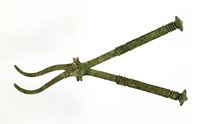  | Ticks are used to remove pieces of bone. It was recommended to remove broken bones with fingers first and then use a tool. |
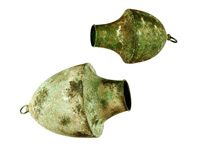  | Roman Bubbles (cucurbitulae). Larger ones were placed on large parts of the body, such as the back or thighs. The smaller ones were used on the hands. |
  | Tubes to prevent spasms and adhesions. After surgery on the nose, anus, and vagina, a bronze or lead tube was used to drain fluids and administer medications. |
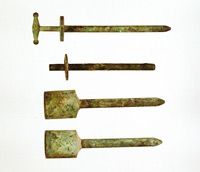  | Enema Tool. |
  | Cauterization plate (ferrum candens). Medics of ancient times used many varieties of this device. Hot cauterizers are still used today to stop tissue or arterial bleeding. |
  | Tool Tray. |
  | Catheter |
  | Maternity hooks (hamus, acutus). They were frequently mentioned in Greek and Roman literature. Both blunt and sharp versions of the tool were used, and they were used in exactly the same way as they are today. |
  | Depilatory forceps. |
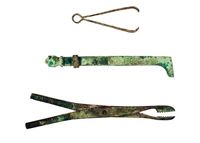  | Language Removal Ticks. Greek medicine expert – Aetius – recalls how the procedure of removing the tongue was performed. The tongue was first pressed tightly with forceps to prevent bleeding, and then it was cut off. |
  | Scalpels |
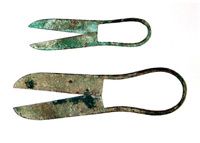  | Operational scissors (forfex). Ancient sources mention the use of such scissors to cut the patient’s hair and obtain more convenient access to the skin. Only a few accounts mention the use of tissue cutting tools. |
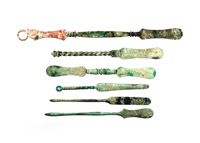  | Tools for mixing medications and applying to wounds. Also used by artists to mix colours. |
  | Drug Delivery Tool. Also used for measuring and mixing medications. |
Dentistry
Ancient Roman dentistry was well developed. The representative of ancient Rome medicine, the aforementioned Cornelius Aulus Celsus (died 48 BCE), also included in his work “De medicina libri octo” how to remove teeth. Initially, you had to scrape the gums and move them, repeating this action until the tooth came loose. The next step was to extract the tooth with your hand, and if it failed, then you had to use special pliers. To leave the root in the socket, it was necessary to use forceps (rhizagra) to remove it. The indications for tooth extraction were: violent pain, odontogenic inflammation, gingival fistula, alveolar abscess and a milk tooth that interfered with the eruption of a permanent tooth. When extracting teeth with a large carious cavity, he filled them with lead beforehand so that the crown would not crumble. He also ordered to put a peppercorn, a berry of ivy or alum into the cavity, which was to crush the tooth. For the same purpose, he also applied a tooth covering with a grinded and melted ray of a ray with resin. Celsus believed, like Hippocrates, that pulling out teeth firmly in the jaw was dangerous.
A contemporary of Celsus, Pliny recommended chewing glaucoma, which is supposed to cause cracking of the tooth roots. He also described a water source that caused the teeth to fall out when drinking. Despite, Celsus recommended removing the gums from the alveolar bone, a large wound was created as a result of extraction with forceps, and parts of the crushed bone could get into the socket, causing it to heal for a long time. Pliny recommended that these bone pieces be found with a probe and removed from the socket to avoid suppuration.
On the other hand, another well-known Roman doctor, Galen, was in favour of keeping the tooth in the mouth as long as possible, and if it was necessary to remove it, he followed the instructions of Celsus. He shook his teeth with his fingers or by covering the periodontium with herbs. He also recommended a canine milk rinse for this purpose.
In ancient Rome, due to the high social demand for dental procedures and the associated profits, not only doctors began to remove teeth. Some of the technicians, who previously only prepared prosthetic restorations, began to extract their teeth right in the streets, making it a fair art.
Doctors became discouraged from extracting teeth, leaving it to their assistants, possibly because extraction was used as a punishment for various kinds of offences. During the torture, teeth were removed with pleasure and hence dentistry has its patron – St. Apolonia who was forced to withdraw from the Christian faith by pulling out all her teeth and breaking her jaw. If it was necessary to extract a tooth, doctors ordered someone to do so. Most often the torturers became skilled during torture and sometimes also got rich from it. In other parts of the world, where the extraction was not a punishment, the attitude of doctors to the procedure was incomprehensively negative.
Healing deities
The Romans had certain deities related to healing. These included Dea Salus – goddess of health, Febris – from feverish diseases, Mars – he protected from the plague as well as the goddess Minerva. Pregnant women were protected by Diana and Juno.
After the plague was spread in 293 BCE, the cult of Asclepius was brought from Greece. Asclepius received a temple in Rome located on the Siberian Island. Soon his name was changed to Aesculapius and two snakes became his symbol. As the borders of the Empire widened more and more, there was a need to organize the medical world. At that time, medical societies and colleges were established. Their patroness was most often the goddess of wisdom and science Minerva.



